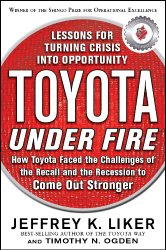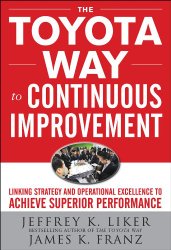Toyota Under Fire Book Review
I recently received a review copy of Toyota Under Fire: Lessons For Turning Crisis Into Opportunity, (Jeffrey Liker and Timothy Ogden) which I am finally getting around to reviewing. Starting with the bottom line up front, I give the book 4.5 stars and a high recommendation. I’ve read quite a bit of Jeffrey Liker’s work, and this most recent installment does not disappoint.
 I’ll give you a frame of reference about how captivating this book was to me. I tend to be a book grazer. I am normally working on 3 or 4 books at any given time, plus, I throw a healthy dose of magazine articles into the mix. After getting past the first chapter, which gives a background about Toyota and its culture, I didn’t read anything other than this book. It held my attention, which is fairly hard to do for more than a handful of chapters.
I’ll give you a frame of reference about how captivating this book was to me. I tend to be a book grazer. I am normally working on 3 or 4 books at any given time, plus, I throw a healthy dose of magazine articles into the mix. After getting past the first chapter, which gives a background about Toyota and its culture, I didn’t read anything other than this book. It held my attention, which is fairly hard to do for more than a handful of chapters.
In a nutshell, the book does two things. First, it provides fact-based evidence refuting the sudden unintended acceleration (SUA) issues that plagued Toyota in the press in 2010. Most Americans get their information from the 24/7 news cycle, and capturing a viewer or reader’s attention in that deluge of headlines takes amplification and sensationalizing of the issues. But very seldom is there any follow-up to a news story that gets anywhere near the same readership as the original barrage of scary headlines. So, despite a lot of evidence contradicting initial claims, there just wasn’t much news coverage related to the investigation into the issue.
Liker and Odgen dive into those subsequent investigations with a focus on facts and data. They discuss the findings of both Toyota and other agencies and present the results very thoroughly and convincingly. The book covers all three main SUA complaints—floor mats, sticky pedals, and electronics.
The second thing the book does is the more important one. It shows how Toyota’s culture helped it weather the storm during back-to-back periods of crises that would have destroyed lesser companies (and in many cases, did!)
In addition the SUA issues, the book also discusses Toyota’s relative success in riding out the recessionary storm. The authors shows how having a strong culture and refined management system in place can protect a company from the inevitable challenges that come with being a leader in a global marketplace.
What I Liked About the Book…
- The book clearly identifies the specific actions Toyota took, sometimes years or decades earlier, that helped Toyota through its crises.
- The book uses great references and scientific data to explain the recall issues.
- The book discusses Toyota’s drive to be profitable while operating at 80% capacity. While excess average capacity has a cost, Toyota recognizes the greater importance of flexibility when crises come about.
- Liker has unrivalled access to Toyota insiders, so he was able to understand not just what people in the organization did to handle the crisis, but also why they did it, and what they were thinking.
- The book clearly articulates a concept about adjusting to takt time that goes over many people’s heads. It explains why it is harder to slow down a production line than it is to speed it up.
- The book looks in detail at what Toyota did in response to the current problems, but also dove into the actions Toyota took to minimize the impact of similar crises in the future.
What I Didn’t Like About the Book…
I was torn whether to give this book 4 ½ stars or five. In the end, there are two main points that I didn’t think I could overlook by giving the book a perfect score.
- The book spends a lot of time talking about the points that Toyota is at the top of the heap on, but barely touches on the situations that show where Toyota’s performance was below its competition. For example, the book discusses the J.D. Powers Initial Quality Survey and mentions that Toyota won in 10 out of 19 categories. It does not explain that, of the 10 mentioned, 5 were for Lexus, and one was for Scion. Still, 4 for Toyota was impressive, but Ford had 3, so the gap was narrower than it seems on the surface. Further, the book does not mention that Toyota only held the overall top spot among the non-luxury nameplates once between 2006 and 2009, even before the recall crisis. It also fails to mention that Hyundai, Ford, and Honda have all have posted at least one score in the last two surveys that beat Toyota’s all time best score. The margin for the Toyota nameplate brand was not quite as wide as the book implies.
- The book is full of specific numbers and references for all the issues except the one regarding floor mats getting stuck. It references the potential for problems with other manufacturers if mats are stacked, but there is not much in the way of comparative data like there is for the other issues. This lack of detail is noticeable when there is so much data provided regarding the other two problems. For this, arguably the most significant of the SUA issues because a death resulted, I would have liked to see more data-based comparisons between Toyota and other models—number of complaints about stuck pedals, actual clearance of the pedals with mats in place, or the stiffness of mats, for example.
Still, despite these two points, as the 4.5 stars implies, I still highly recommend the book. The authors masterfully weave the story of what happened with lessons that the reader can take away and apply to their own operations.
A Funny Story…
I’ve had this article nearly done for quite a while now, and had entitled this section “What I’d Like to See Jeffrey Liker Write Next”. And then before I got around to finishing this review, I received the exact book I had dreamed up in the mail from his staff. I had wanted to see something on how the principles Toyota uses have actually been applied to other companies. And I got it before I even asked in the form of The Toyota Way to Continuous Improvement: Linking Strategy and Operational Excellence to Achieve Superior Performance.
So why did I want to see this book? One of my main concerns about Toyota is not what they do. I think they are a great company, and are consistently at the top (or near the top) of the heap by virtually any measure. What bothers me is the near cult-like following of all things Toyota that is pervasive in the Lean community. Many people seem to advocate doing things a particular way just because it is done that way by Toyota. Referencing Toyota is done as if it is a Supreme Court ruling. Linking one’s Lean pedigree to Toyota is common in the consulting world because of the implied credibility it carries, not because of any actual statistically significant performance of said mentor.
I certainly think Toyota has a lot to offer, but nobody can copy them precisely, nor should they. Other organizations should combine ideas from Toyota with those of other successful organizations, and add in a healthy dose of original thought to create their own flavor of improvement. And then they should continue to improve on the culture they develop.
Now that my “pro-Toyota”, “anti-Toyota cult” ramblings are done, I’ll conclude by saying that it looks like Mr. Liker has seen some of the same problems developing, and is attempting to show how the lessons he has been teaching for years have actually been used to achieve success outside of Toyota.
The original section that was made irrelevant when I got the book…
I now have five of Liker’s books on my shelf, and like them all. They paint a great picture of how Toyota runs its business, and how those methods, cultures, and values led to its current success. He is a great author, and tells compelling tales, which makes his book educational, as well as an easy, entertaining read.
But I think he has written enough on how Toyota does things, and how it has gotten to where it is. I would love to see Liker take on the challenge of observing how other companies have actually used The Toyota Way to successfully elevate the performance of their own organization.
Many companies use bits and pieces of what Toyota does to varying degrees of success. But I have yet to see a thorough analysis from anyone of what the common factors are for the successful ones. I think the most valuable thing Liker could do at this point for the average company wanting to improve would be to give them a clear, proven, step-by-step guide on how to build a culture modeled on Toyota’s. It would be great for the Lean community to see examples of companies that have successfully emulated Toyota’s business practices to achieve top-of-class performance in their own industry.



0 Comments